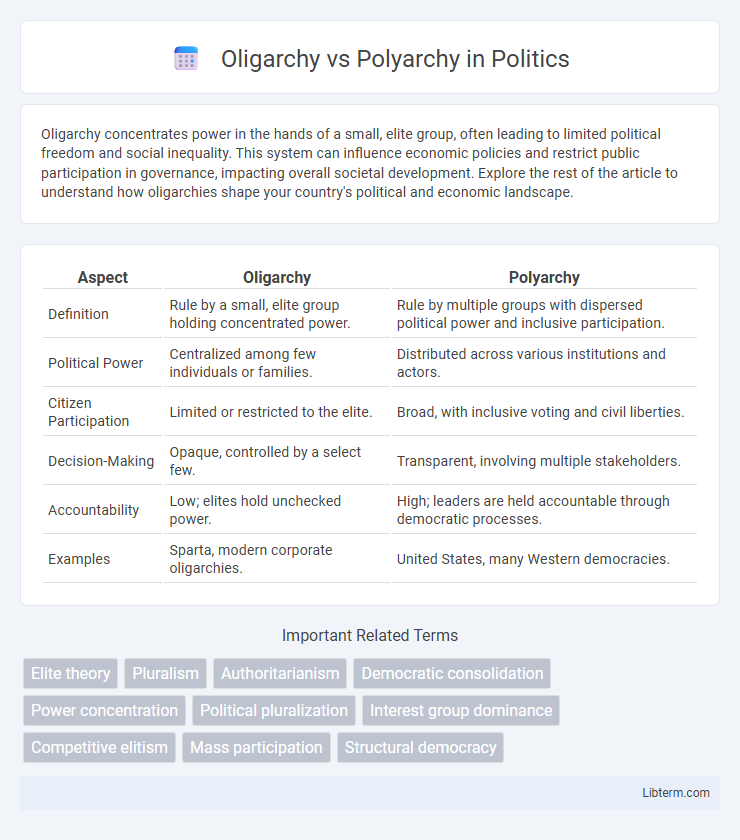Oligarchy concentrates power in the hands of a small, elite group, often leading to limited political freedom and social inequality. This system can influence economic policies and restrict public participation in governance, impacting overall societal development. Explore the rest of the article to understand how oligarchies shape your country's political and economic landscape.
Table of Comparison
| Aspect | Oligarchy | Polyarchy |
|---|---|---|
| Definition | Rule by a small, elite group holding concentrated power. | Rule by multiple groups with dispersed political power and inclusive participation. |
| Political Power | Centralized among few individuals or families. | Distributed across various institutions and actors. |
| Citizen Participation | Limited or restricted to the elite. | Broad, with inclusive voting and civil liberties. |
| Decision-Making | Opaque, controlled by a select few. | Transparent, involving multiple stakeholders. |
| Accountability | Low; elites hold unchecked power. | High; leaders are held accountable through democratic processes. |
| Examples | Sparta, modern corporate oligarchies. | United States, many Western democracies. |
Defining Oligarchy and Polyarchy
Oligarchy is a political system where power is concentrated in the hands of a small, elite group, often based on wealth, family ties, or military control, limiting broad citizen participation. Polyarchy, a concept introduced by political scientist Robert Dahl, refers to a form of government characterized by widespread participation, competitive elections, and multiple centers of power, promoting democratic governance. The defining difference lies in oligarchy's restricted power structure versus polyarchy's inclusive and pluralistic political process.
Historical Origins of Oligarchy and Polyarchy
Oligarchy, originating in ancient Greek city-states like Sparta, concentrated power in the hands of a few elite families or individuals, often justified by wealth or military control. Polyarchy emerged as a concept describing modern democratic systems, with roots in 20th-century political theory by Robert Dahl, emphasizing pluralism and competitive elections that disperse power among multiple groups. Historical analysis reveals oligarchies maintained control through exclusivity and aristocratic dominance, while polyarchies evolved to promote broader citizen participation and institutional checks on authority.
Key Characteristics of Oligarchic Systems
Oligarchic systems concentrate power in the hands of a small, elite group, often distinguished by wealth, family ties, or military control, limiting political participation for the broader population. Decision-making is centralized, with policies favoring the interests of the ruling few rather than the general public, resulting in restricted political freedoms and reduced accountability. Such systems typically suppress dissent and maintain control through institutional mechanisms that prevent widespread democratic engagement.
Core Features of Polyarchic Democracies
Polyarchic democracies are characterized by inclusive political participation, competitive elections, and the protection of civil liberties, ensuring broad citizen involvement and accountability in governance. These systems promote pluralism and power dispersion, preventing dominance by a small elite, unlike oligarchies where political power is concentrated. Transparent institutions and an active civil society support the functionality of polyarchies, enhancing democratic legitimacy and responsiveness to the public.
Power Distribution: Elite Control vs. Pluralism
Oligarchy concentrates power in the hands of a small elite group, limiting political influence to a narrow segment of society, which often leads to centralized decision-making and restricted citizen participation. Polyarchy, by contrast, embraces pluralism, distributing power across multiple competing groups and institutions to ensure broader representation and inclusive governance. This decentralized power structure in polyarchies fosters competition, political freedom, and accountability, contrasting sharply with the elite dominance characteristic of oligarchies.
Decision-Making Processes in Both Systems
Oligarchy centralizes decision-making power in the hands of a few elites, leading to policies that primarily serve their interests with limited public input or accountability. In contrast, polyarchy emphasizes inclusive decision-making through competitive elections, multiple political parties, and broad citizen participation, fostering transparency and responsiveness. The effectiveness of governance in each system depends on how power distribution influences policy formulation and public engagement.
Oligarchy and Polyarchy in Modern Governance
Oligarchy in modern governance concentrates power within a limited group, often leading to restricted political competition and limited citizen participation, which can undermine democratic principles. Polyarchy represents a system characterized by multiple centers of power, inclusive political participation, and competitive elections, fostering pluralism and accountability in contemporary democracies. The contrast between oligarchy and polyarchy highlights critical differences in power distribution, political freedom, and institutional responsiveness within modern political systems.
Impacts on Social Equity and Political Participation
Oligarchy concentrates power in the hands of a few, resulting in limited political participation and significant social inequities as decision-making privileges are restricted to an elite group. Polyarchy promotes broader political participation and strives for greater social equity by enabling more inclusive governance and representation of diverse social groups. Empirical studies show polyarchic systems tend to reduce economic disparities and foster civic engagement compared to oligarchic regimes.
Case Studies: Real-World Examples
Oligarchy is exemplified by Russia, where a small group of elite figures controls political power and economic resources, limiting public participation. Polyarchy is illustrated by countries like the United States, where multiple institutions and broad electoral participation ensure competitive governance and accountability. Venezuela represents a hybrid case with oligarchic tendencies within a formally democratic framework, showcasing challenges in maintaining polyarchic principles.
Future Trends: Evolving Political Structures
Future trends in political structures indicate a gradual shift from traditional oligarchies, where power is concentrated among a few elites, towards polyarchies characterized by broader participation and pluralism. Digital technology and increased access to information empower citizens, fostering transparency and accountability in governance. Emerging models emphasize hybrid systems integrating centralized control with decentralized participation to balance stability and inclusiveness in evolving democracies.
Oligarchy Infographic

 libterm.com
libterm.com